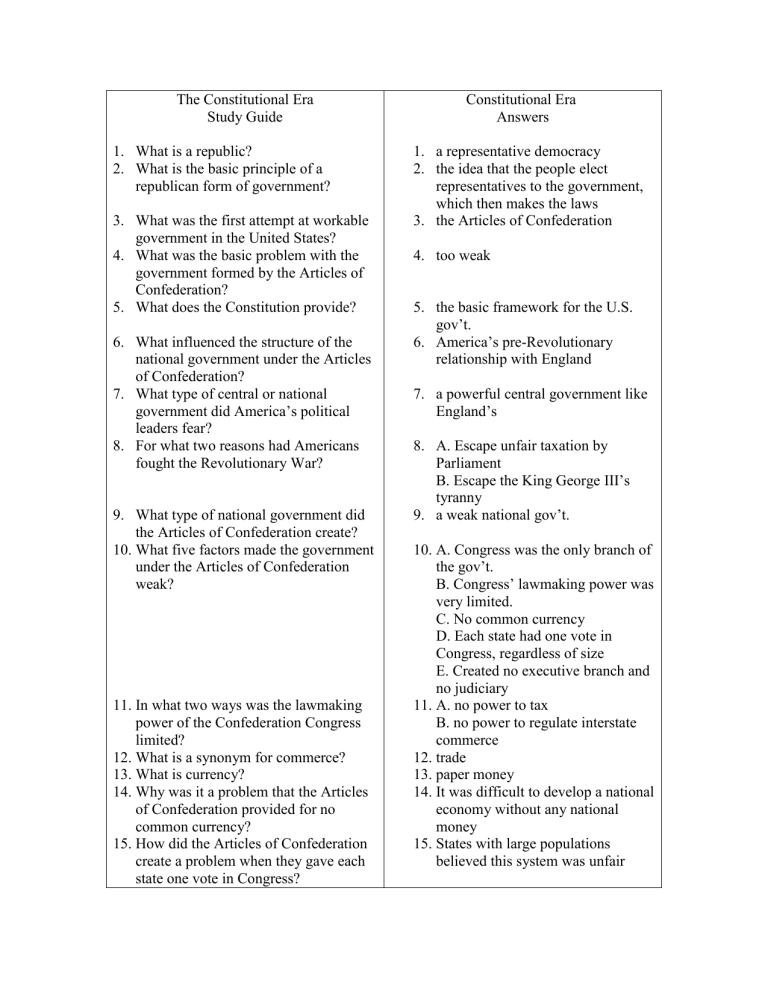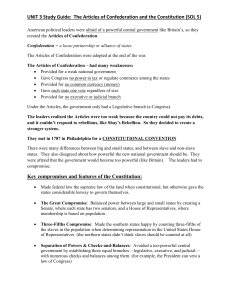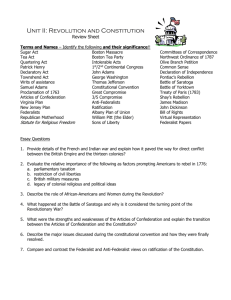Constitution Cornell

The Constitutional Era
Study Guide
1.
What is a republic?
2.
What is the basic principle of a republican form of government?
3.
What was the first attempt at workable government in the United States?
4.
What was the basic problem with the government formed by the Articles of
Confederation?
5.
What does the Constitution provide?
6.
What influenced the structure of the national government under the Articles of Confederation?
7.
What type of central or national government did America’s political leaders fear?
8.
For what two reasons had Americans fought the Revolutionary War?
9.
What type of national government did the Articles of Confederation create?
10.
What five factors made the government under the Articles of Confederation weak?
11.
In what two ways was the lawmaking power of the Confederation Congress limited?
12.
What is a synonym for commerce?
13.
What is currency?
14.
Why was it a problem that the Articles of Confederation provided for no common currency?
15.
How did the Articles of Confederation create a problem when they gave each state one vote in Congress?
Constitutional Era
Answers
1.
a representative democracy
2.
the idea that the people elect representatives to the government, which then makes the laws
3.
the Articles of Confederation
4.
too weak
5.
the basic framework for the U.S. gov’t.
6.
America’s pre-Revolutionary relationship with England
7.
a powerful central government like
England’s
8.
A. Escape unfair taxation by
Parliament
B. Escape the King George III’s tyranny
9.
a weak national gov’t.
10.
A. Congress was the only branch of the gov’t.
B. Congress’ lawmaking power was very limited.
C. No common currency
D. Each state had one vote in
Congress, regardless of size
E. Created no executive branch and no judiciary
11.
A. no power to tax
B. no power to regulate interstate commerce
12.
trade
13.
paper money
14.
It was difficult to develop a national economy without any national money
15.
States with large populations believed this system was unfair
16.
What does the executive branch of a government do?
17.
What does the judicial branch of a government do?
18.
How did the Articles’ failure to create either an executive or judicial branch weaken the new national government?
19.
Where did the Constitutional
Convention meet?
20.
What three issues divided the delegates to the Constitutional Convention?
21.
What is a compromise?
22.
What three things did the Constitution of the United States do?
23.
What two Virginians played important roles at the Constitutional Convention?
24.
Why was George Washington an important figure at the Constitutional
Convention?
25.
Why was James Madison an important figure at the Constitutional
Convention?
26.
Who wrote the “Virginia Plan”?
27.
What did the “Virginia Plan” do?
28.
Why was the “Virginia Plan” important?
29.
What is another name for national law?
30.
What does it mean to say that federal law is the supreme law of the land?
31.
Did the Constitution allow the states to keep considerable power to govern themselves?
16.
enforces the laws
17.
interprets or explains the meaning of the laws
18.
The new gov’t. could neither enforce its laws nor settle disputes if Americans disagreed over what the laws meant.
19.
Philadelphia, Pennsylvania
20.
A. Large states vs. Small states
B. How should national government and states divide power
C. Slavery
21.
an agreement in which both sides get part of what they want, but neither gets all of what it wants
22.
A. Established a gov’t. that shared power between the national government and state gov’ts.
B. Protected the rights of states
C. Provided a way to amend or change the Constitution
23.
George Washington and James
Madison
24.
because he served as chairman, gave the Convention legitimacy
(people trusted the Convention)
25.
often led the debate, kept a written record of the Convention
26.
James Madison
27.
Proposed a federal government of three separate branches: the legislative, the executive, and the judicial
28.
It became the foundation for the structure of the new government.
29.
federal law
30.
when state law conflicts with federal law, then the federal law takes precedent over (knocks out) the state law
31.
Yes
32.
How did the Constitution balance power between large and small states?
33.
What are the two houses of Congress?
34.
How is a state’s membership in the
United States Senate determined?
35.
How is a state’s membership in the
United States House of Representatives determined?
36.
What states had decided to abolish or end slavery in the years immediately following the Revolution?
37.
Why had the northern states decided to abolish slavery in the years immediately following the Revolution?
38.
What states had decided to keep slavery after the Revolution?
39.
Why had the southern states decided to keep slavery in the years after the
Revolution?
40.
Did the northern states want slaves to be counted when determining the slave states’ membership in the House of
Representatives?
41.
Did the southern states want slaves to be counted when determining the slave states’ membership in the House of
Representatives?
42.
What compromise did the northern and southern states make regarding the slave states’ membership in the House of Representatives?
43.
What was this compromise called?
44.
How did James Madison answer
Americans’ concern about making the national government under the
Constitution too powerful?
45.
Define the term separation of powers.
46.
What three governmental branches did the Constitution create?
47.
What is the name of the legislative branch of the federal government?
48.
What does the legislative branch do?
49.
What official leads the executive
32.
made Congress a two-house
33.
34.
35.
legislature
Senate and House of
Representatives each state gets 2 senators by the size of a state’s population; the more people, the more representatives
36.
northern states
37.
recognized that slavery contradicted the idea of the Declaration of
Independence that “all men are created equal”
38.
southern states
39.
financial greed (made money off slave labor) and racial prejudice
40.
No
41.
Yes
42.
counted each slave as 3/5 of a person when determining the slave states’ populations
43.
the 3/5 compromise
44.
proposed a federal gov’t. of 3 separate branches, which divided power and governmental responsibilities
45.
The division of power among different branches of gov’t.
46.
legislative, executive, and judicial
47.
Congress
48.
makes the laws
49.
President
branch of the federal government?
50.
What does the executive branch do?
51.
What court leads the judicial branch of the federal government?
52.
What does the judicial branch do?
53.
Why did the Constitution include a checks and balance system?
54.
Define the term checks and balance system.
55.
How else did the Constitutional
Convention try to restrain or check the federal government’s power?
56.
How many states had to ratify the
Constitution before it could take effect?
57.
What does ratify mean?
58.
Who were the Federalists?
59.
Who were the Anti-Federalists?
60.
Give four reasons why the Federalists supported the Constitution.
61.
What does interstate mean?
62.
What does interstate commerce mean?
63.
Give two reasons why the Anti-
Federalists opposed the Constitution.
64.
What did the Anti-Federalists force the
Federalists to do during the state ratification conventions?
65.
Name one of the Federalist leaders during the ratification process.
66.
Who took responsibility for creating a
50.
enforces the laws
51.
Supreme Court
52.
interprets or explains the meaning of the laws
53.
so that none of the three branches would become too powerful
54.
a system by which each branch of gov’t. can check or stop the actions of the other branches
55.
by limiting the federal gov’t. to those powers specifically identified in the Constitution
56.
9
57.
approve
58.
supported ratification (approval) of the Constitution
59.
opposed ratification of the
Constitution
60.
A. favored a strong national gov’t. that shared some power with the states
B. believed a strong national gov’t. was necessary for interstate commerce, foreign trade, national defense, and foreign relations
C. said the U.S. was not too big for a republic, because the different groups would check each other
D. said a Bill of Rights was not necessary
61.
between states
62.
trade between states
63.
A. believed a strong national gov’t. would take away power from the state gov’ts.
B. believed a Bill of Rights was necessary
64.
promise to adopt a Bill of Rights as soon as the Constitution took effect
65.
James Madison
66.
James Madison
Bill of Rights?
67.
What two documents did Madison consult when he worked on the Bill of
Rights?
68.
Who wrote the Virginia Declaration of
Rights?
69.
What was the main idea of the Virginia
Declaration of Rights?
70.
Who wrote the Virginia Statute of
Religious Freedom?
71.
What did the Virginia Statute of
Religious Freedom forbid?
72.
Which church had been the established church in colonial Virginia?
73.
Define the term established church.
74.
What basic idea did the Virginia Statute of Religious Freedom support?
75.
What is the Bill of Rights?
76.
What is a constitutional amendment?
77.
What rights are guaranteed by the First
Amendment?
78.
What does freedom of assembly mean?
79.
What does the right of petition mean?
80.
Did ratification of the Constitution end debate in the United States on the issue of governmental power?
81.
Does debate over the meaning of the
Constitution still continue today?
67.
68.
69.
70.
Thomas Jefferson
71.
an established church
72.
Virginia Declaration of Rights and
Virginia Statute of Religious
Freedom
George Mason set forth the idea that gov’ts. should not violate basic human rights
Anglican Church
73.
the practice of gov’t. support for one favored church (everyone had to give money to this church)
74.
religious freedom
75.
the first ten amendments to the
Constitution
76.
an addition to the Constitution
77.
freedom of speech, freedom of religion, freedom of the press, freedom of petition, and freedom of assembly
78.
the right to gather at public meetings
79.
the right to make written requests for changes in the gov’t.
80.
No
81.
Yes







